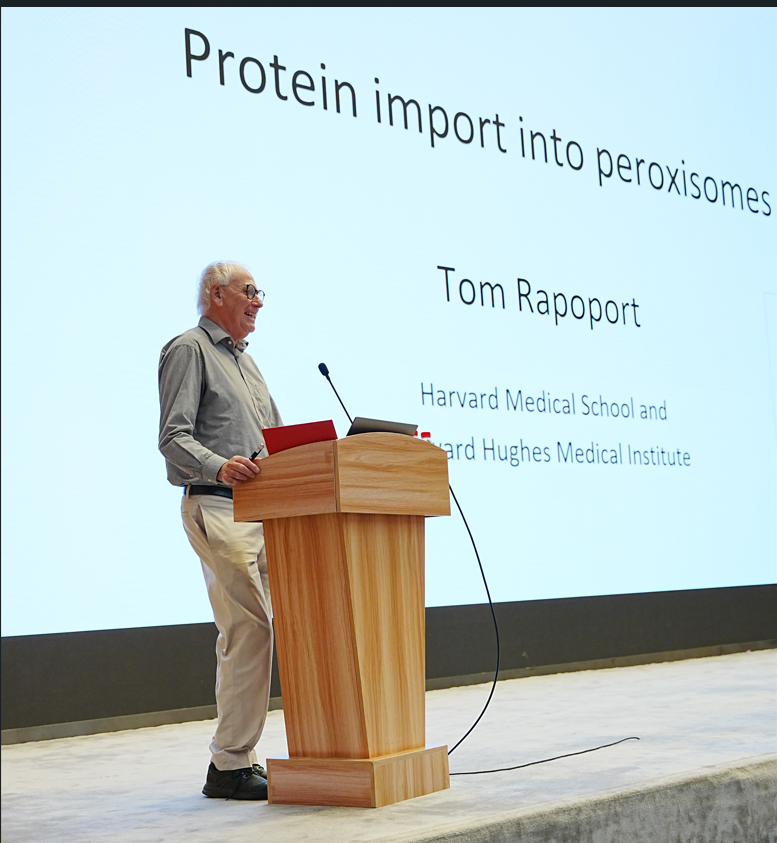On November 6, 2024, at the invitation of Associate Professors Yanfen Liu and Min Zhuang from the School of Life Science and Technology at ShanghaiTech University, Professor Tom Rapoport, a distinguished scientist at Harvard Medical School, investigator at the Howard Hughes Medical Institute, and member of both the American and German National Academies of Science, delivered an insightful lecture titled Protein Import into Peroxisomes in Building 10, 100 Haike Road.

The Rapoport Lab is interested in the mechanisms by which proteins are transported across membranes, how misfolded proteins are degraded, and how organelles form and maintain their characteristic shapes. Most of the projects center around the endoplasmic reticulum (ER). One project concerns the molecular mechanism by which proteins are translocated across the ER membrane or across the plasma membrane in bacteria and archaea. Much of the current work deals with ERAD (ER-associated protein degradation), a process in which misfolded proteins are retro-translocated across the ER membrane into the cytosol. Major questions concern the mechanism by which proteins move across the membrane and are extracted by the Cdc48 ATPase. Another project concerns the mechanism by which ER morphology, specifically the tubular ER network, is generated. More recently, the Rapoport lab has started to study how proteins are imported into peroxisomes, and how lung surfactant proteins generate lamellar bodies. The lab employs a variety of different techniques, including biochemical methods, such as reconstitutions with purified proteins, and structural biology methods, including X-ray crystallography and cryo-electron microscopy.
Peroxisomes are ubiquitous organelles whose dysfunction causes fatal human diseases. Most peroxisomal enzymes are imported in a folded state from the cytosol by the receptor PEX5. Recent work shows how PEX5 shuttles cargo into peroxisomes, PEX5 binds cargo in the cytosol and then enters peroxisomes by a process resembling nuclear transport. A meshwork is formed inside the membrane by a conserved tyrosine/glycine-rich YG domain of PEX13, and resembles the meshwork of nucleoporin FG domains inside nuclear pores. PEX5 selectively partitions into this phase, using conserved aromatic motifs, and brings bound cargo along. PEX5 returns to the cytosol through a retro-translocon formed by a ubiquitin ligase complex, consisting of PEX2, 10, and 12. The ligase complex has an open pore, into which the import receptors insert a flexible N-terminal segment from the luminal side. Following mono-ubiquitination, PEX5 is pulled out of peroxisomes by the PEX1/6 ATPase. During retro-translocation, PEX5 is unfolded, which results in cargo release, inside the organelle. After folding and deubiquitination, PEX5 can start a new import cycle.
Professor Rapoport’s lecture ignited a lively discussion among the audience by delving into the mechanisms of cargo-receptor movement into and out of the peroxisome and the involvement of peroxisomal proteins.
Professor Tom Rapoport’s Biography
Tom Rapoport, Ph.D., joined the faculty at Harvard Medical School in 1995. He received his Ph.D. in Biochemistry from the Humboldt University in East-Berlin for work in enzymology. He then focused on mathematical modeling of metabolism, for which he received his second degree (Habilitation) from the same institution. Before moving to the US, he worked at the Central Institute of Molecular Biology of the Academy of Sciences of the GDR and later at the Max-Delbrueck Center for Molecular Medicine in Berlin-Buch. In 1997, he became a Howard Hughes Medical Institute Investigator. He was elected as a member of the National Academy of Sciences in the United States in 2008.


